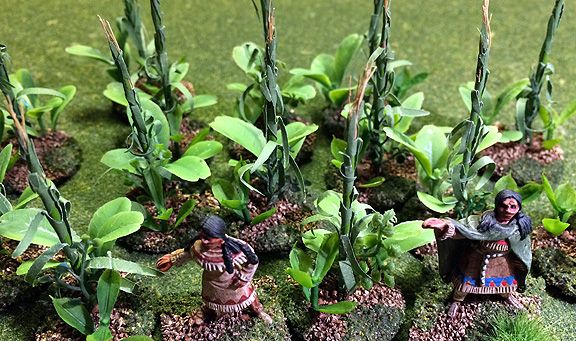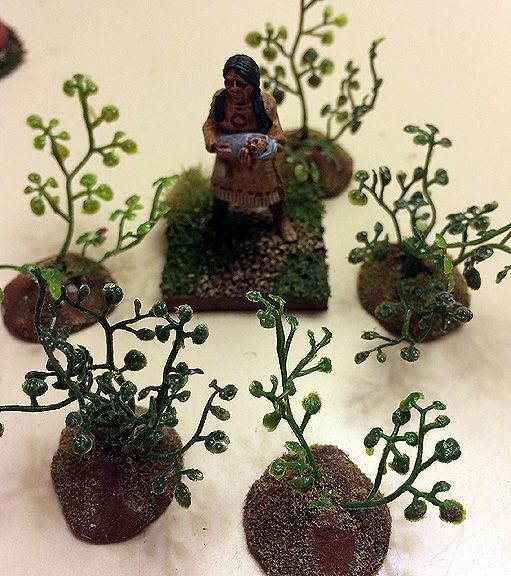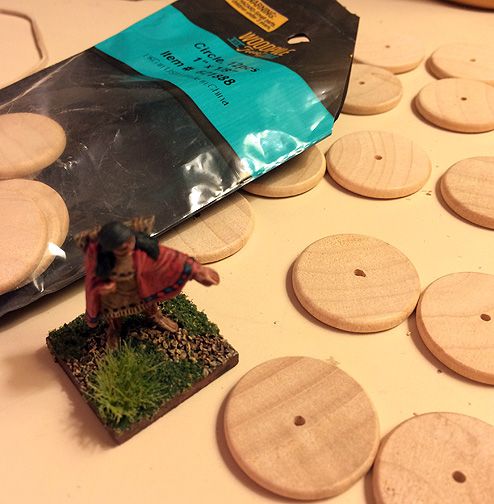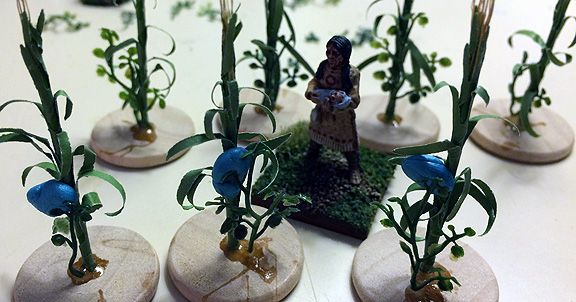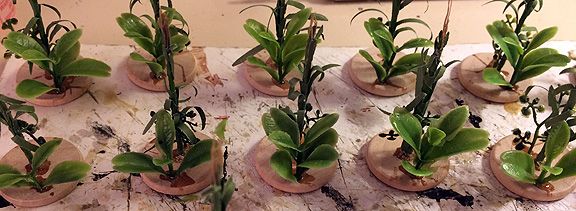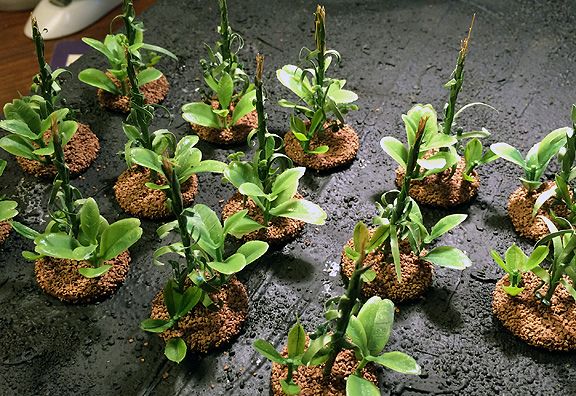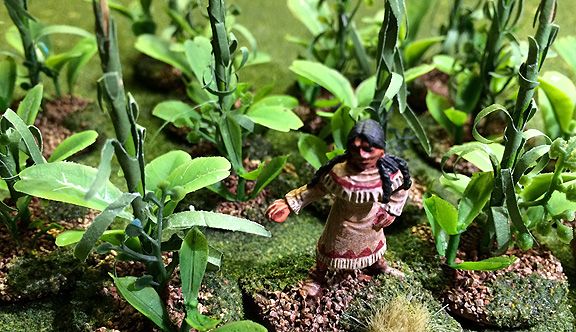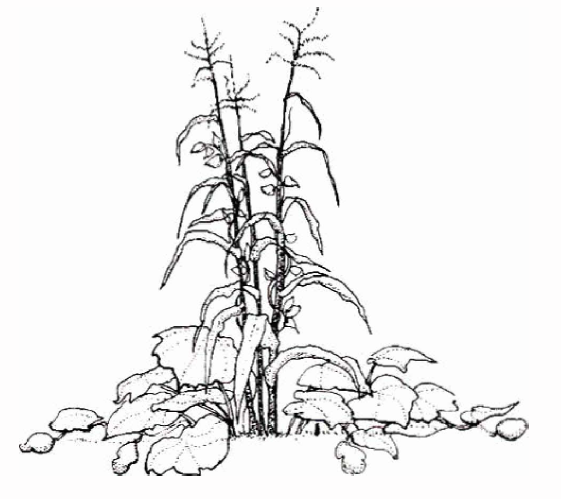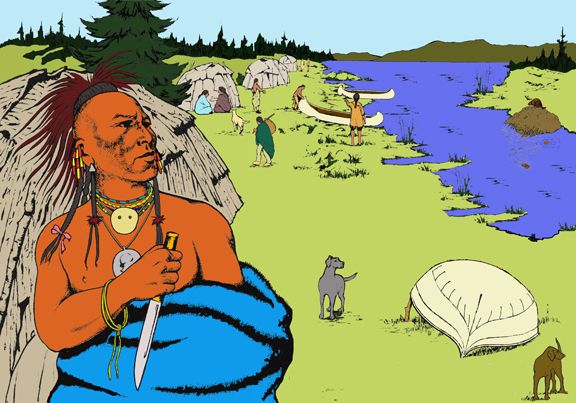My players keep getting better and better at emailing in their strategic orders (choice of War 1 through 8 or Hunt 1 through 8 cards). We were finished with our group email within a week, allowing me to publish the "Order of Play" in plenty of time to pre-select our opponents. Those with the highest numbered War cards declar first, followed by the lowest Hunt cards. Typically, it means the top four attack one of the bottom four, but since the Susquehannock player could not make it to our chosen Saturday to game out the battles, I had my Erie tribe (second in order of play with a "War 3" card) attack his tribe (third in order of play). I told him we would pick a time to fight out our battle, letting the other six players who showed up all get their game in.
Our Order of Play and scenarios for this round were:
Order: Seneca > Erie > Susquehannock > Miami > Mohawk > Shawnee > Neutrals > Kickapoo
• Seneca attacked the Kickapoo, rolling “Give Them Time”
• Erie attacked the Susquehannock, rolling “Hold Them at the Gates”
• Miami attacked the Shawnee, rolling “A Shot Rang Out”
• Mohawk attacked the Neutrals, rolling “Tracks in the Mud”
 |
| Kickapoo hunters at bottom and left flee before the Seneca onslaught, after their leader is killed |
A couple of the battles were slam dunks, so to speak. In fact, Mike S and Andy were finished with their game so quickly that they set it up and played it again! In "Give Them Time," a Kickapoo hunting party detects the approach of a Seneca warband intent on attacking their village. The swiftest runners are sent back to warn the village, but the leader of the hunting party decides it must circle around onto the rear of the raiders and attack, causing them to halt their advance and turn and face this unknown threat. The board is completely forest covered, except for a path snaking from one side to the other. The Seneca turned on the surprise attack fiercely, killing the brave Kickapoo leader early in the skirmish. The Kickapoo quickly lost heart and many fled the field.
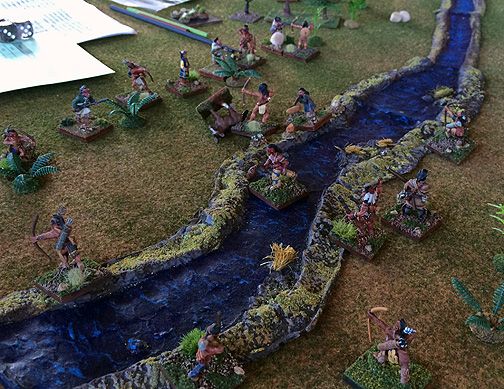 |
| Miami hunters, right, cross a creek and brush-choked ravine to close with an intruding Shawnee hunting party. In the top center, a horse figure stands in for the deer carcass (I *do* have to get around to painting a deer kill one of these days!) |
The next game was a long, bitter struggle between two rival groups of hunters. A Miami hunting party is investigating the sound of a matchlock shot in what they consider their hunting grounds. They find a Shawnee hunting party across a creek, beginning to cut apart the deer carcass for carrying. That shout out their war cries, telling the intruders that this is their hunting lands, given to them by their fathers. The Shawnee are defiant, and matchlocks are loaded, arrows nocked, and the two bands of hunters closed in on each other looking for larger game than deer. Joe, the Shawnee player, had deployed cleverly so that the Miami would be slowed down and disordered crossing the creek and a ravine. He kept his braves in a tight line, hoping that the Miami would be forced to attack piecemeal. The struggle raged back and forth, with both sides suffering losses. Both Shawnee and Miami had to pass morale checks as their numbers dropped below half. Eventually, the Shawnee simply outlasted the Miami. Three battered Shawnee stood guard over the deer, for which much blood had been shed. The lone surviving Miami hunter raced off to tell his tribe about the trespass and the brave attack his companions had made.
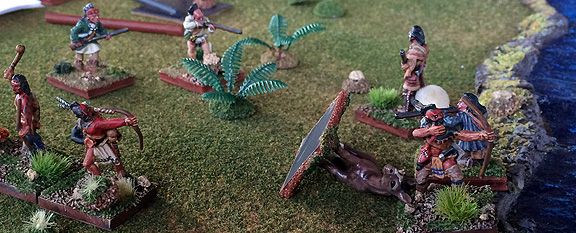 |
| The closing stages of the fight -- much Miami and Shawnee blood is shed over the deer. The skirmish rages until only 3 Shawnee and 1 Miami are left. |
The third battle fought on a frigid Saturday (but we were warm inside the pizzeria!) was called "Tracks in the Mud." A hunting party from the Neutrals tribe returns to where they've hidden their canoes in the brush by a creek. One of the hunters notices strange moccasin tracks in the mud. A ripple of alarm goes through the hunters' ranks, and they quickly fan out to face possible ambush from the forest. Within seconds, they see a Mohawk hunting party stalking towards them through the trees. For a more detailed report on this battle, I highly encourage you to check out Keith Finn's gaming blog. He is blogging a turn by turn report of his participation in the playtest. The link for Keith's blog is here:
OrcaFinn's Basement
 |
| On the right, the Neutral hunting party fans out to face the forest after discovering strange moccasin tracks near their hidden canoes. Mohawks stalk towards them on the left. Sad to say, I forgot to bring my canoes -- it would have been only the second time they made it to the tabletop! |
Unfortunately, this was another "slam dunk" battle. Our leader after the first round of the campaign, Dave's Mohawk tribe, has fallen on hard times in the last two turns, suffering two major defeats. His strategy to maximize the number of beaver pelts his tribe obtains each turn is keeping him in the middle of the pack despite the losses, though, in 5th place out of eight.
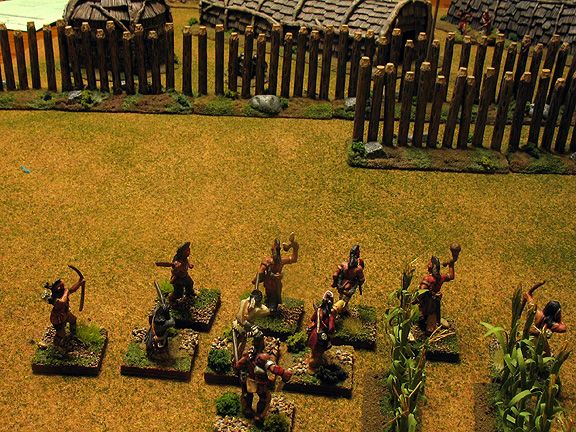 |
| The Erie attacking force: Four Warriors armed with Primitive Weapons and bow in the front, three with matchlock in the second rank, two Youths with bow on the flanks to beef up my numbers slightly, and the Erie chieftain with matchlock in the back. |
Two days later, Steve and I got together to fight out the Erie-Susquehannock clash. Going in to this round, Steve's tribe was in the lead. He would have double the number of upgrades that my tribe had. This is tracked by the number of Scenario Victory Points (SVPs) each tribe has accumulated from its battles. These points -- Steve had eight, I had four -- can be used to buy Traits from
Song of Drums and Tomahakws rules, such as "Marksman," "Strong," etcl. Players do know which scenario they will play before selecting their roster, so I knew it would be "Hold the Gates." My Erie raiding party has slipped close to a Susquehannock town and are racing for the gates. Word of our attack has just been shouted by women racing in from the fields. So, a force is quickly collected to hurry and stop us at the gates before we enter. Knowing that I would need to close quickly, I used all four of my upgrade points to give "Primitive Weapon" to four of my warriors. They would be my spearhead and seek to engage in hand to hand -- not taking time to shoot.
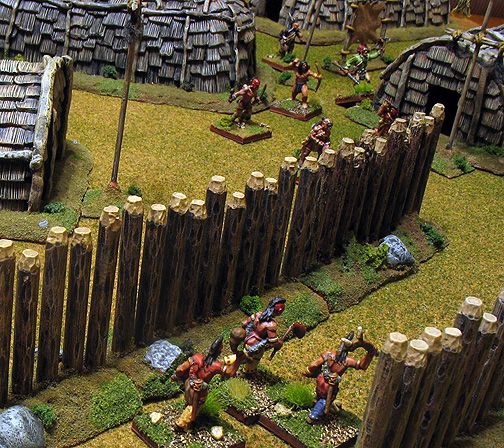 |
| My spearhead of warriors with Primitive Weapons races through the winding passageway that was the "gate" of many early Native American towns. Beyond the palisades, you can see the Susquehannock force mustering to dispute our entrance. |
As for shooting, Steve's level of Beaver Pelts meant he had 4 upgrades of Bow to Matchlock. I had only three, but the attacker in a scenario always gets a bonus one, so we'd be even on that. As it turned out, there was a minimum of shooting in our battle. Like I envisioned, it would be settled in melee at the gates of the Susquehannock town. However, it was a desperate struggle. I would be on the losing end for most of it, until a final, fatal blow turned the tide in my favor.
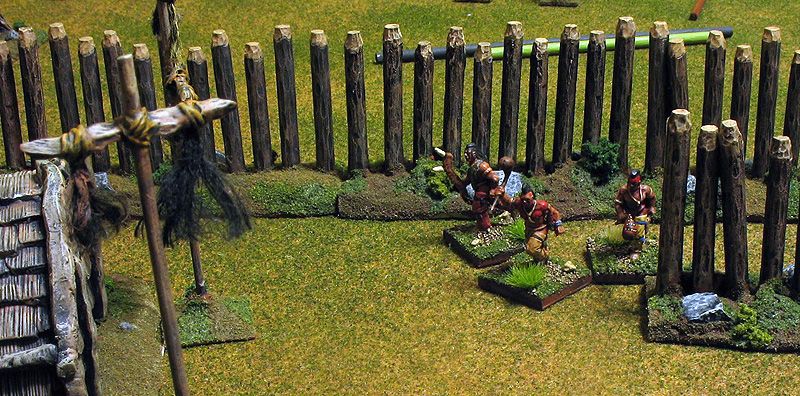 |
| This is where nearly all of the fighting and killing would take place, between the palisades and a birch bark lodge, beneath the scalp poles that celebrated the triumphs of the men of this town. |
My activation rolls were subpar the first few turns, as I managed to move only three figures before "crapping out" -- as we call it -- on the first turn, and two figures on the next. However, those first three figures boldly raced into the entranceway of the palisaded town. They were met by about half of the Susquehannock force. Some lingered back in Steve's deployment area (the leader had raced ahead and he was having trouble ordering them to move up), while two matchlock-armed braves circled to catch me in the flank as I began to pour through the entrance. Even though I was outnumbered, I thought I would have the advantage. The force meeting me at the entrance was mostly Youths, along with a couple braves and his Leader. However, the Susquehannock youths knew that the town was watching them, and that their deeds would be sung around the campfires if they triumphed. Steve's youths gave as good as they received from my warclub wielding warriors. When Steve's leader entered the fray, things began to swing in his favor.
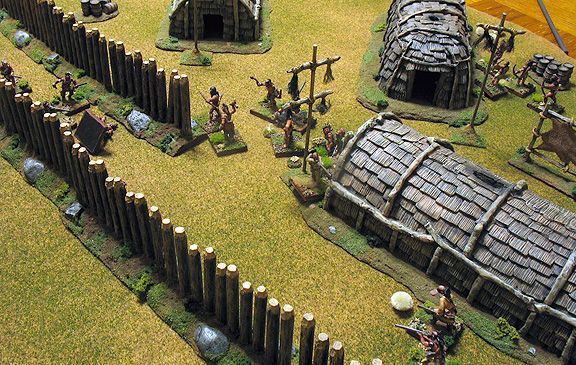 |
| A good overview of the battle: Two Susquehannock warriors with matchlock seek to flank my raiders as they enter the town, while my force continues to trickle forward in the passageway to reinforce the first raiders to arrive. |
We were killing some of our enemy, but were losing more. The Erie warleader knew the crisis point had arrived when five of his 10 raiding party had fallen. One more loss, and the men would likely begin to break. So, he shouted a warcry and charged into the fray, confronting the Susquehannock leader, who had just cut down one of his braves. Throughout most of the game, my combat dice had been subpar -- with Steve's youths consistently holding off my stronger warriors. It was payback time, though, as Steve rolled a "1" and I tossed a "6"! This sparked an immediate morale check for his entire force. One disadvantage of selecting the cheaper Youths on your roster is they have the trait "Wavering." This means they are -1 when rolling morale checks. Seeing their chieftain cut down, the Susquehannock youths raced for the rear. Enough ran offtable to force Steve to immediately take the "Below 50%" morale check that I had been dreading. Two checks in a row meant almost all of his force fled offtable. Somehow, miraculously, the Erie had won the battle that had been going steadily against them. Our tribe's first campaign victory was all the more sweet because we were in last place going in, while Steve had been in first!
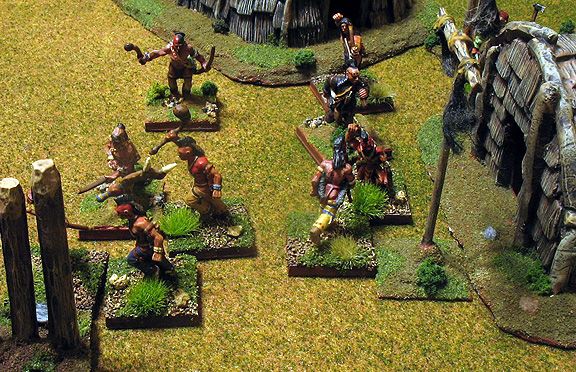 |
| The bloody and brutal battle for the gates of the town rages |
One of the things I am really liking about this campaign is that each scenario gives you a chance to tailor your force for the mission. Players are given 20 campaign army points to spend on their force: Leaders cost 4, Warriors 2, and Youths 1. We have seen forces that featured lots of Youths, and those that featured mostly Warriors (like mine in the last battle). Also, it allows the players to use some of the Traits in the rules that we might not in a straight-up, convention event. The Beaver Wars campaign is allowing players to experiment with tactics and weapon combinations. It is all part of presenting players with a tactical puzzle. If a game is simply about who rolls better dice, then its attraction may fade after awhile. One of the best features of
Song of Drums and Tomahawks is the players are constantly presented with decisions and choices. Which figure do I activate first? How many dice should I roll -- balancing out the chance of "crapping out" and losing my turn against the objectives I need to accomplish on this turn, and overall. Players are constantly wondering, "What's the most important thing for me to do at this moment?" The campaign setup is complimenting that without adding in complicated or time-consuming logistics.
Here is the leaderboard, showing where each tribe is at if the campaign were to end on this turn:
|
Tribe
|
Place
|
Victory Points
|
|
Neutrals
|
1st
|
20.5 points
|
|
Shawnee
|
2nd
|
18 points
|
|
Susquehannock
|
3rd
|
15 points
|
|
Seneca
|
4th
|
14 points
|
|
Mohawk
|
5th
|
12.5 points
|
|
Erie
|
6th
|
10 points
|
|
Kickapoo
|
Tied 7th
|
9 points
|
|
Miami
|
Tied 7th
|
9 points
|
The points come from their rankings in three categories: Battlefield victories (Prestige Points); Scenario Victory Points; Beaver Pelts collected. I've pasted below each of the three separate tables showing the rankings in each category.
Prestige Points (3 for a Major Victory, 2 for a Minor Victory, 1 for a Minor Defeat, 0 for a Major Defeat)
|
Tribe
|
Prestige Points (PPs)
|
|
Shawnee (Joe Merz)
|
7 (1 MajV, 2 MinV)
|
|
Neutrals (Keith Finn)
|
7 (2 MajV, 1 MinD)
|
|
Seneca (Mike Stelzer)
|
7 (1 MajV, 2 MinV)
|
|
Susquehannock (Steve Phallen)
|
4 (1 MajV, 1 MinD)
|
|
Erie (Mike Demana)
|
4 (1 MajV, 1 MinD)
|
|
Mohawk (Dave Welch)
|
3 (1 MajV)
|
|
Miami (Jenny Torbett)
|
3 (1 MinV, 1 MinD)
|
|
Kickapoo (Andy Swingle)
|
1 (1 MinD)
|
Beaver Pelts (these are obtained by your position in the Turn Order -- the least aggressive stance, or highest numbered Hunt card played, receives 8 pelts, next 7, then 6, and so on. You also steal a pelt by defeating an opponent with a Major Victory)
|
Tribe
|
Beaver Pelts
|
|
Mohawk (Dave Welch)
|
18
|
|
Kickapoo (Andy Swingle)
|
17
|
|
Neutrals (Keith Finn)
|
16
|
|
Susquehannock (Steve Phallen)
|
16
|
|
Shawnee (Joe Merz)
|
14
|
|
Erie (Mike Demana)
|
10
|
|
Miami (Jenny Torbett)
|
10
|
|
Seneca (Mike Stelzer)
|
7
|
Scenario Victory Points (these are obtained from each scenario your tribe plays in)
|
Tribe
|
Scenario Victory Points (SVPs)
|
|
Neutrals (Keith Finn)
|
44
|
|
Shawnee (Joe Merz)
|
43
|
|
Seneca (Mike Stelzer)
|
37
|
|
Susquehannock (Steve Phallen)
|
36
|
|
Miami (Jenny Torbett)
|
28
|
|
Erie (Mike Demana)
|
25
|
|
Mohawk (Dave Welch)
|
18
|
|
Kickapoo (Andy Swingle)
|
15
|
If you are interested in purchasing a copy of the battle rules we use for the campaign,
Song of Drums and Tomahawks, click here:
First Command Wargames website
Our next turn will be in two weeks, so keep checking back here for more reports on the playtest of the
Beaver Wars in Ohio campaign rules!
